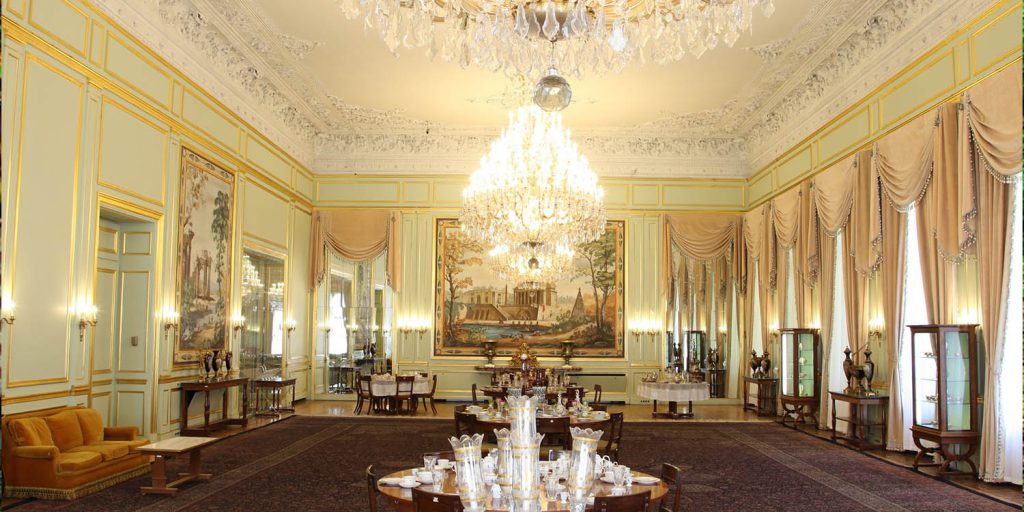It is a 300 hectare complex in the north of Tehran, which was founded and enlarged by the kings of the Qajar and Pahlavi periods. This historic complex has around 180 hectares of natural forest, as well as several palaces, mansions, museums and numerous buildings, aqueducts, gardens, greenhouses and streets.
This resort was built in the Shemiran area, near Darband and on the slopes of the Alborz mountain range. This resort is bordered by the Alborz Mountains to the north, Golabodreh to the east, Velenjak to the west and Tajrish to the south. The Jafarabad River flows through the middle of the palace grounds.

The average annual temperature of this region is estimated at 12.9 degrees Celsius and it is located at an altitude of 1,650 to 1,800 meters above sea level.
After the 1978 revolution, this complex became a museum and the current Presidential Palace is located next to this complex. At present, several palaces and buildings of this complex are in the possession of the Presidential Institution of Iran.
The Saadabad complex has passed through four historical Qajar periods, first Pahlavi and second Pahlavi and after the Iranian revolution. Saadabad was built during the Qajar period and was the summer residence of the kings of that dynasty.
After the coup d’etat of 1920 and its occupation by the Pahlavi dynasty, several buildings were built there, accommodating 18 palaces of different sizes.
Each of the buildings was the residence of a member of the Pahlavi family. Mohammad Reza Pahlavi also settled there in the 1971s, the construction of which was completed early in his reign.
This palace is the oldest palace in the Saadabad complex, which was built at the end of the reign of Ahmad Shah and from (1918) and ended during the wartime reign of Reza Shah.
This palace was used as a natural history museum in the first years after the Iranian revolution, but is now in the possession of the President of the Republic of Iran and is inaccessible to the public.
During the Pahlavi period, this palace was the place of the last years of Reza Shah’s life before his exile in Mauritius and the place of residence of the mother of the Shah (Taj al-Muluk) until the time of the Islamic Revolution from Iran. This palace currently belongs to the Presidential Institution of Iran and is reserved for special guests of the Iranian government. This is why it became the building of the Republic. This palace is also currently inaccessible to the public.
The Shahvand Palace or Green Palace is located on a high point, northwest of the Saadabad complex. The palace was originally a semi-finished building that belonged to a person named Alikhan, and the hill on which the building was located was known as Alikhan Hill. Reza Shah, after purchasing the building on this hill from Alikhan, built and constructed the present palace and its completion lasted from the time of his war ministry until the beginning of his reign (1922 to 1928). This palace was built on two floors (basement and ground floor) with the efforts of Iranian artists and architects, after seven years of work. Reza Shah used the ground floor as a residence and office and the basement as a warehouse. There was also a sumptuous dining room with sculpted tables and chairs, as well as exquisite Italian porcelain, ceramics and silverware for the ceremonial reception of guests. This palace is also known as a stone palace or a marble palace due to the use of rare green stones from Zanjan’s Khamseh mine and Khorasan marble in its exterior.
The White House of Saadabad
This palace is the largest palace in the Saadabad palace complex, known as the White House due to its white color. This building, in addition to being dedicated to the administrative and ceremonial affairs of the Pahlavi era, was considered the summer residence of Mohammad Reza Shah and his wife Farah Pahlavi. The palace consists of 54 different units, including 10 ceremonial rooms, the largest of which is the Palace Hall, which includes a dining hall with an area of 220 square meters. Construction of the palace, by order of Reza Shah, began in 1931 and ended in 1936.